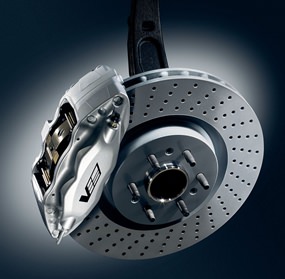A little history if I may. Ever since man managed to make contraptions that were self propelled, man very quickly afterwards found that he needed a reliable way to pull up. The first to experience this was a military steam tractor, which with a top speed of three km/h managed to knock down a wall on its maiden outing. The fact that it weighed several tonnes did not help the retardation process either.
It was further back than you imagine, and was in 1769, and that very first self-propelled road vehicle was a military tractor invented by French engineer and mechanic, Nicolas Joseph Cugnot (1725 – 1804). Cugnot used a steam engine to power his vehicle, built under his instructions at the Paris Arsenal by mechanic Brezin. Apart from knocking down walls, it was used by the French Army to haul artillery at three km/h on only three wheels.
 Disc brakes
Disc brakes
During the late 1800’s, we began to see many more self-propelled vehicles, and with the diversity in designs, there were also many different retardation devices. These included brakes on the fly wheel, or on the prop shaft, rather than at the wheels. And if you would like some other interesting facts, the disc brake was patented by British engineer Frederick William Lanchester in 1902. It did not gain immediate acceptance as although it was reasonably efficient for the slow moving vehicles of the time, it was noisy. Very noisy, with the copper brake pads running against the disc.
The next technological advance to come to grips with Lanchester’s disc brakes came from another engineer, Herbert Frood (later to become Ferodo). Frood lined the pads with asbestos and solved the noise problem but the disc brake would not become standard in Europe until much later, by which stage, the world had found out that asbestos was a dangerous material.
Another of the famous names in automotive history is Ransom E. Olds (Oldsmobile) who demonstrated just how much better deceleration he could provide with his early drum brake which featured a stainless steel band wrapped around a drum on the rear axle. It certainly was better than the stick on a tyre brake of the hansom cabs of the day.
This external drum brake was not without problems either. On hills, where the brake unwrapped, motorists could not rely entirely on this design. This led to another very crude piece of technology called the ‘sprague’, which was a metal spike which when released would stick in the ground behind the car and stop it running backwards!
We have certainly come a long way since then. My racing Escort for example, uses EBC pads giving it a stopping power of the next best thing to a brick wall!




